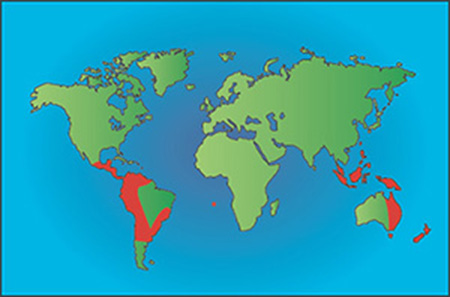One of the earliest land plants
Overview
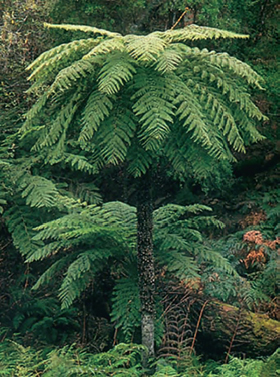
Ferns appeared among the earliest land plants about 400 million years ago, long before the dinosaurs. The earliest Australian fern macrofossil is from the Early Carboniferous period, 340 million years ago. Ferns were important in establishing the atmospheric and soil conditions for the evolution of the conifers and later the flowering trees we are familiar with today. As the diversity of conifers and flowering plants increased, the numbers of fern species fell.
The ferns that are found today are not the same as those early ferns although some have similar characteristics to fossils of ancient ferns. Today’s ferns have been influenced by the same changes that caused other plants and animals to evolve.
Ferns have a worldwide distribution from Greenland to the Antarctic and from sea level to high altitudes. Some genera, such as the stag and elkhorn ferns [Platycerium] have a purely southern hemisphere distribution, others such as the shield ferns [Polystichum] are found world wide.
All ferns require moisture for their spores to reproduce, hence they are common in moist environments such as creeks, springs and shaded gullies. However some ferns inhabit very dry sites, losing their fronds in the summer and resting through this inhospitable period.
»Follow this link to view a map with the locations of the collection highlighted.
»Follow this link to view the full interpretive panel in PDF format.
Dicksonia and Cyathea
The soft tree fern (Dicksonia antarctica), often called a man fern in Tasmania because of its size, is common in Tasmania. The genus Dicksonia, of about 25 species, also occurs in mainland Australia and New Zealand, and on high mountains in both Papua New Guinea and islands through the Indonesian archipelago. The name 'soft tree fern' is derived from the feel of the base of the frond. Slow growing at about 3cm per year, a 1.8m specimen is about 60 years old.
Another tree fern genus is the Cyathea. Much faster growing than the Dicksonia, the species Cyathea australis, commonly known as the rough tree fern, can grow to 20m in the same 60 years. Several other species occur in Tasmania. This genus has 800 species and also occurs in warmer forests in Australia, in New Zealand and into the sub tropics and tropics.
An interesting fern relative is the forked fern. Nearly always found growing among the root fibres of soft tree ferns, they have no true roots themselves. Tmesipteris, with about 13 species in the genus, is an example found in the South Pacific region, including Australia.
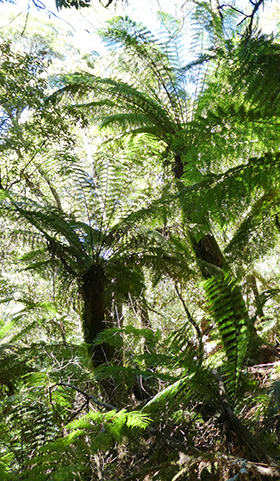
Tasmanian Ferns
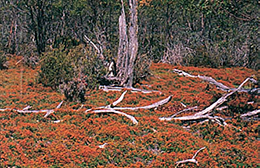
Ferns found in Tasmania have been classified into 101 species, with 81 ferns and 20 fern allies. Fern allies share the characteristics of ferns, but do not have the ferns’ stem and leaf structure.
Fern habitat includes wet forest [47 species], dry forest [15], alpine [13], coastal heathland [11], aquatic [8], wetland scrub [6], and seashore [1]. They grow in the soil [terrestrial], on trees [epiphytic], on rock [lithophytic] or in water [aquatic]. Terrestrial ferns are the most common with 79 species. 23 of these species also have the capacity to grow on trees or rocks.
Of the 101 species considered Tasmanian, 88 also occur in Victoria and 68 in New Zealand, with lesser numbers in the other states and territories.
While Tasmania may seem 'fern rich', one species has not been seen for some time, another six species are are not known to occur in any secure Tasmanian reserve, and another 12 are considered poorly reserved. Overall, that’s 19% of the Tasmanian species that may be considered under threat.
Distribution
These maps show the Southern Hemisphere bias of 'Tree Fern' distribution.
Cyathia
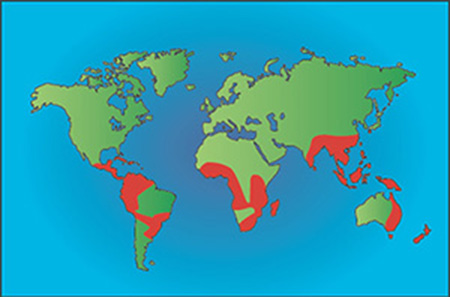
Dicksonia
